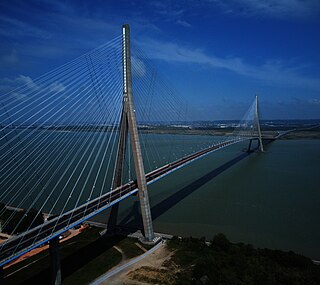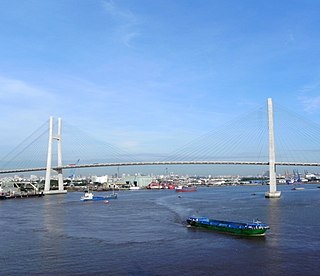History
The bridge was commissioned on 18 October 1975, after three years of construction. Including its 404 m central span, the 720 m metal structure held, at its construction, the world record length for a cable-stayed metallic bridge.
In 1992, the Loire-Atlantique general council took over the Saint-Nazaire SAEM, the contractor for the creation and operation of the bridge. Access to the bridge became toll-free on 1 October 1994.
The building was returned to the department's general council road heritage organization, which has been responsible for its management and maintenance since 1 August 1995. It has improved trading between the north and the south shores of the estuary considerably.
In 1975, the bridge was the longest one ever built in France. Moreover, it held the world record for the longest cable-stayed bridge for eight years.
Traffic rules and regulations
The speed limit is 70 km/h. Certain or even all vehicles may restricted during strong winds (starting at 80 km/h for cyclists).
The general council has implemented a lane management system for the bridge. The reversible lanes allow, during the day or special events, for a second lane to be dedicated to the busier way. The system has folding barriers, with illuminated red studs that are embedded in the asphalt, and road sign frames that allow for illuminated road signs (green arrow/orange or red cross) to indicate the way that is assigned to each of the three lanes.
Unique in France, the system went live on 25 August 2010 and is regarded as "experimental". In fact, it is a requirement from the state since the traffic code mandates white markings on the ground. The Loire-Atlantique general council has, therefore, received a one-year permit that has renewed every year since then.
However, the illuminated beacons have become too fragile because of the LEDs.
Also, the increased traffic during the summer causes numerous traffic jams despite the system.
To offer an alternative way of crossing the river for pedestrians and cyclists during the summer (May to September), in June 2010 the general council considered a river shuttle service between Saint-Nazaire and Mindin. Because of its prohibitive cost, the idea was abandoned in December 2011.
The only regular coach lines using the bridge and providing intercity connections between Saint-Nazaire and the Pays de Retz region are those of the Lila network (routes 15, 16 and 17). Route 17 vehicles are fitted with eight bicycle-only spaces.

A cable-stayed bridge has one or more towers, from which cables support the bridge deck. A distinctive feature are the cables or stays, which run directly from the tower to the deck, normally forming a fan-like pattern or a series of parallel lines. This is in contrast to the modern suspension bridge, where the cables supporting the deck are suspended vertically from the main cable, anchored at both ends of the bridge and running between the towers. The cable-stayed bridge is optimal for spans longer than cantilever bridges and shorter than suspension bridges. This is the range within which cantilever bridges would rapidly grow heavier, and suspension bridge cabling would be more costly.

Saint-Nazaire is a commune in the Loire-Atlantique department in western France, in traditional Brittany.

The Jacques Cartier Bridge is a steel truss cantilever bridge crossing the Saint Lawrence River from Montreal Island, Montreal, Quebec, to the south shore at Longueuil, Quebec, Canada. The bridge crosses Saint Helen's Island in the centre of the river, where offramps allow access to the Parc Jean-Drapeau and La Ronde amusement park.

The Millau Viaduct is a multispan cable-stayed bridge completed in 2004 across the gorge valley of the Tarn near Millau in the Aveyron department in the Occitanie Region, in Southern France. The design team was led by engineer Michel Virlogeux and English architect Norman Foster. As of October 2023, it is the tallest bridge in the world, having a structural height of 343 metres (1,125 ft).

The Rio–Antirrio Bridge, officially the Charilaos Trikoupis Bridge, is one of the world's longest multi-span cable-stayed bridges and longest of the fully suspended type. It crosses the Gulf of Corinth near Patras, linking the town of Rio on the Peloponnese peninsula to Antirrio on mainland Greece by road. It opened one day before the Athens 2004 Summer Olympics, on 12 August 2004, and was used to transport the Olympic flame.

The Vasco da Gama Bridge is a cable-stayed bridge flanked by viaducts that spans the Tagus River in Parque das Nações in Lisbon, the capital of Portugal.

The Pont de Normandie is a cable-stayed road bridge that spans the river Seine linking Le Havre to Honfleur in Normandy, northern France. Its total length is 2,143.21 metres (7,032 ft) – 856 metres (2,808 ft) between the two piers. It is also the last bridge to cross the Seine before it empties into the ocean. It is a motorway toll bridge with a footpath and a narrow cycle lane in each direction allowing pedestrians and cyclists to cross the bridge free of charge, while motorcycling is also toll-free.

The Severn Bridge is a motorway suspension bridge that spans the River Severn between South Gloucestershire in England and Monmouthshire in South East Wales. It is the original Severn road crossing between England and Wales, and took three and a half years to build, at a cost of £8 million. It replaced the 137-year-old Aust Ferry.

An extradosed bridge employs a structure that combines the main elements of both a prestressed box girder bridge and a cable-stayed bridge. The name comes from the word extrados, the exterior or upper curve of an arch, and refers to how the "stay cables" on an extradosed bridge are not considered as such in the design, but are instead treated as external prestressing tendons deviating upward from the deck. In this concept, they remain part of the main bridge superstructure.

The Bandra–Worli Sea Link is a 5.6 km long, 8-lane wide cable-stayed bridge that links Bandra in the Western Suburbs of Mumbai with Worli in South Mumbai. It is the second longest sea bridge after Mumbai Trans Harbour Link, as well as the 5th longest bridge in India after Mumbai Trans Harbour Link, Bhupen Hazarika Setu, Dibang River Bridge and Mahatma Gandhi Setu. It contains pre-stressed concrete-steel viaducts on either side. It was planned as a part of the proposed Western Freeway that would link the Western Suburbs to Nariman Point in Mumbai's main business district, but is now planned to become part of the Coastal Road to Kandivali.

Bouvron is a commune in the Loire-Atlantique department in western France.

The Incheon Bridge is a reinforced concrete cable-stayed bridge in South Korea. At its opening in October 2009, it became the second bridge connection between Yeongjong Island and the mainland of Incheon. The Incheon Bridge is South Korea's longest spanning cable-stayed bridge. In comparison, it is the world's sixteenth longest cable-stayed bridge as of January 2019.

The Phú Mỹ Bridge is a cable-stayed road bridge over the Saigon River in Ho Chi Minh City, Vietnam.

Tours station is a railway station serving the city of Tours, Indre-et-Loire department, western France. It is situated on the Paris–Bordeaux railway, the Tours–Saint-Nazaire railway, and the non-electrified Tours–Le Mans railway. The Gare de Tours is a terminus; most TGV trains only serve the nearby Gare de Saint-Pierre-des-Corps.

Pont Briwet refers to the road and railway bridges that cross the River Dwyryd, near Penrhyndeudraeth, Gwynedd in North Wales. The first bridge was a Victorian road and railway viaduct that was constructed entirely from timber by the Cambrian Railways company. Although it was recognised as being a Grade II listed structure, a result of it being an increasingly rare example of a surviving 19th-century wooden road and railway viaduct, the condition of the bridge had deteriorated over time and by the 21st century was posing regular and considerable inconvenience to both road and rail traffic.

The James D. Pfluger Pedestrian and Bicycle Bridge is a shared use bridge for pedestrians and cyclists spanning Lady Bird Lake in downtown Austin, Texas. Opened in 2001, the bridge connects the north and south sides of the Ann and Roy Butler Hike-and-Bike Trail and features an unusual "double curve" design. The bridge runs parallel to the Lamar Boulevard Bridge, which carries road traffic across the lake roughly 200 feet (61 m) to the west.

The Samuel-De Champlain Bridge, colloquially known as the Champlain Bridge, is a cable-stayed bridge design by architect Poul Ove Jensen and built to replace the original Champlain Bridge over the Saint Lawrence River in Quebec, between Nuns' Island in the borough of Verdun in Montreal and the suburban city of Brossard on the South Shore. A second, connected bridge links Nuns' Island to the main Island of Montreal. It is the busiest bridge in the country with more cars flowing into it than any other bridge.

The Departmental Council of Loire-Atlantique, called the 'General Council of Loire-Inférieure' between 1800 and 1957, then 'General Council of Loire-Atlantique' until 2015, is the deliberative assembly of the French department of Loire-Atlantique. Its headquarters are in Nantes.
The Saint-Just-Saint-Rambert bridge, also known as the "Grand Pont sur la Loire", is a suspension bridge located in the Loire department that spans the Loire at Saint-Just-Saint-Rambert. It facilitates the deviation of the departmental road D 498, which links the A72 autoroute to the west of the town of Bonson.



















